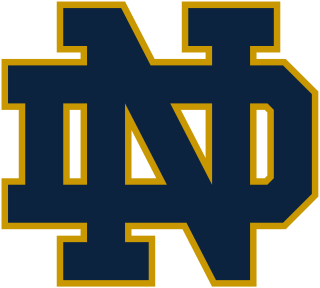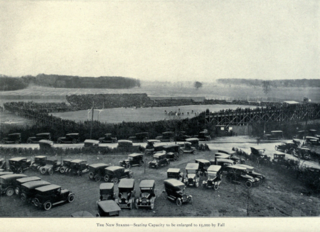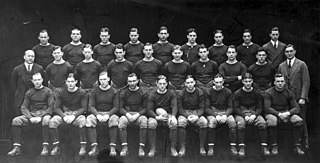Related Research Articles

The Notre Dame Fighting Irish football team is the intercollegiate football team representing the University of Notre Dame in Notre Dame, Indiana, north of the city of South Bend, Indiana. The team plays its home games at the campus' Notre Dame Stadium, which has a capacity of 77,622. Notre Dame is one of four schools that competes as an Independent at the National Collegiate Athletic Association (NCAA) Football Bowl Subdivision (FBS) level; however, they play five games a year against opponents from the Atlantic Coast Conference (ACC), of which Notre Dame is a member in all other sports except ice hockey.
The Dickinson System was a mathematical point formula that awarded national championships in college football. Devised by University of Illinois economics professor Frank G. Dickinson, the system ranked national teams from 1924 to 1940.
Raymond Joseph Eichenlaub was an American gridiron football player. Nicknamed "Eich", he was best known for playing college football for the University of Notre Dame.

Cartier Field was a stadium in Notre Dame, Indiana, first dedicated on May 11, 1900, as an arena for football, baseball, track and field, and bicycling. It hosted the University of Notre Dame Fighting Irish football team from 1900 to 1928 and held nearly 30,000 people at its peak. The stands were torn down after the 1928 season to make room for Notre Dame Stadium, which opened in 1930. Notre Dame played its entire 1929 schedule away from campus, went undefeated (9–0) and won the National Championship. At Coach Knute Rockne's insistence, Cartier Field's grass was transplanted into Notre Dame Stadium.
The 1928 football season had both the USC Trojans and the Georgia Tech Golden Tornado claim national championships. USC was recognized as champions under the Dickinson System, but the Rose Bowl was contested between the No. 2 and No. 3 Dickinson-rated teams, California and Georgia Tech. The game was decided by a safety scored after Roy "Wrong Way" Riegels ran 65 yards in the wrong direction. Vance Maree blocked the ensuing punt which gave Georgia Tech a safety deciding the 8–7 win.
The 1929 college football season saw a number of unbeaten and untied teams. Purdue, Tulane, Notre Dame and Pittsburgh all finished the regular season with wins over all their opponents. Notre Dame was recognized as national champion by two of three contemporary major selectors, while the third (Houlgate) named USC (10–2). Eight of nine retrospective selectors later also named Notre Dame and USC as No. 1 teams.
The 1931 college football season saw the USC Trojans win the Knute Rockne Memorial Trophy as national champion under the Dickinson System, as well as the No. 1 position from each of the other three contemporary major selectors. Rockne, who had coached Notre Dame to a championship in 1930, had been killed in a plane crash on March 31, 1931. For the first time, the champion under the Dickinson System also played in a postseason game. The 1932 Rose Bowl, promoted as a national championship game between the best teams of East and West, matched USC and Tulane, No. 1 and No. 2 in the Dickinson ratings. USC won, 21–12, and was awarded the Albert Russel Erskine Trophy.
The 1935 college football season was the last one before the Associated Press (AP) writers' poll was used in selecting the national champion. There were seven contemporary math system selectors that year who are informally recognized by the NCAA as "nationwide in scope". The Dickinson System, run by University of Illinois Professor Frank Dickinson, selected Southern Methodist University (SMU) as best in the nation. The Houlgate System, created by Carroll Everard "Deke" Houlgate Sr., also selected SMU. The contemporary Boand, Litkenhous and Poling math rating systems all selected Minnesota as the No. 1 team in the nation. The Dunkel System selected Princeton as its top team. The Williamson System, by Paul O. Williamson of New Orleans, ranked Texas Christian University first.
The 1946 Notre Dame Fighting Irish football team was an American football team that represented the University of Notre Dame as an independent during the 1946 college football season. In their fourth year under head coach Frank Leahy, the Irish compiled an 8–0–1 and were ranked No. 1 in the final AP Poll. The season also produced the 1946 Army vs. Notre Dame football game, a scoreless tie between undefeated teams ranked No. 1 and No. 2.

The 1924 Notre Dame Fighting Irish football team was an American football team that represented the University of Notre Dame as an independent during the 1924 college football season. In their seventh season under head coach Knute Rockne, the Fighting Irish compiled a perfect 10–0 record, defeated Stanford in the 1925 Rose Bowl, and outscored opponents by a total of 285 to 54. The team was led by the legendary backfield known as the "Four Horsemen" consisting of quarterback Harry Stuhldreher, halfbacks Don Miller and Jim Crowley, and fullback Elmer Layden.
The 1929 Notre Dame Fighting Irish football team was an American football team that represented the University of Notre Dame as an independent during the 1929 college football season. In their 12th year under head coach Knute Rockne, the Irish compiled a perfect 9–0 record and outscored opponents by a total of 145 to 38, with four shutouts.
The 1930 Notre Dame Fighting Irish football team was an American football team that represented the University of Notre Dame as an independent during the 1930 college football season. In their 13th and final season under head coach Knute Rockne, the Fighting Irish compiled a perfect 10–0 record and outscored their opponents by a total of 256 to 74 with three shutouts.
The 1940 Notre Dame Fighting Irish football team was an American football team that represented the University of Notre Dame as an independent during the 1940 college football season. In their seventh season under head coach Elmer Layden, the team compiled a 7–2 record and outscored opponents by a total of 168 to 67. The team played its home games at Notre Dame Stadium in South Bend, Indiana.
The 1939 Notre Dame Fighting Irish football team represented the University of Notre Dame during the 1939 college football season.
The 1938 Notre Dame Fighting Irish football team represented the University of Notre Dame during the 1938 college football season.
The 1932 Notre Dame Fighting Irish football team was an American football team that represented the University of Notre Dame as an independent during the 1932 college football season. In its second season under head coach Hunk Anderson, the team compiled a 7–2 record and outscored opponents by a total of 255 to 31. Paul Host was the team captain. The team played its home games at Notre Dame Stadium in South Bend, Indiana.
The 1928 Notre Dame Fighting Irish football team represented the University of Notre Dame during the 1928 college football season. Led by eleventh-year head coach Knute Rockne, the independent Irish compiled an uncharacteristic 5–4 record and were outscored 99 to 107. The defeat of Army was the Win one for the Gipper game.
The 1927 Notre Dame Fighting Irish football team represented the University of Notre Dame during the 1927 college football season. Although most selectors have named either Illinois or Georgia as the 1927 national champion, Notre Dame was retroactively named as the national champion by one selector, the Houlgate System. The team was ranked No. 4 in the nation in the Dickinson System ratings released in December 1927.

The 1925 Notre Dame Fighting Irish football team was an American football team that represented the University of Notre Dame as an independent during the 1925 college football season. In its eighth season under head coach Knute Rockne, the team compiled a 7–2–1 record and outscored opponents by a total of 200 to 64.
The 1928 Carnegie Tech Tartans football team represented the Carnegie Institute of Technology as an independent during the 1928 college football season. Led by 14th-year head coach Walter Steffen, the Tartans compiled a record of 7–1. No November 17, Carnegie Tech beat Notre Dame at Cartier Field, the first time the Fighting Irish had been defeated at home in 23 years. Carnegie Tech played home games at Forbes Field in Pittsburgh. The team was ranked No. 6 in the nation in the Dickinson System ratings released in December 1928.
References
- ↑ "Stanford Eleven Adjudged Best: Navy Ranks Second Under Dickinson System of Rating Teams". The Morning Post. Camden, N.J. December 17, 1926. p. 23 – via Newspapers.com.
- ↑ "Notre Dame wears green to continue a proud uniform tradition vs. Ohio State". USA TODAY. Retrieved September 23, 2023.
- ↑ "Notre Dame rips Georgia Tech". The Indianapolis Star. October 31, 1926. Retrieved December 9, 2023– via Newspapers.com.
- ↑ Kenneth S. Conn. "Rox Win Homecoming Game". The South Bend Tribune. p. 1 – via Newspapers.com.
- ↑ "Rockmen Take Another Step Towards National Crown". The South Bend Tribune. p. Sports 5 – via Newspapers.com.
- ↑ Hughes, Robert W. (November 28, 1926). "Carnegie Tech springs greatest surprise of football season by beating Notre Dame". Pittsburgh Press. p. 1.
- ↑ 2014 Notre Dame Fighting Irish football media guide. Retrieved 2015-Jul-12.